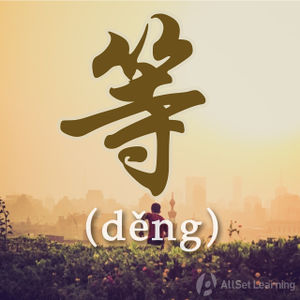Difference between revisions of "Non-exhaustive lists with "dengdeng""
| Line 1: | Line 1: | ||
{{Grammar Box}} | {{Grammar Box}} | ||
{{Stub}} | {{Stub}} | ||
| − | |||
| − | |||
等等 (děng děng), or simply 等, has the same meaning as “and so on” or “etc.” in English. Both are placed after a series of items (the list of which generally exceeds two items). | 等等 (děng děng), or simply 等, has the same meaning as “and so on” or “etc.” in English. Both are placed after a series of items (the list of which generally exceeds two items). | ||
Revision as of 05:38, 4 February 2013
-
Level
-
Similar to
-
Used for
-
Keywords
| This article is a stub. Editors can help the Chinese Grammar Wiki by expanding it. |
等等 (děng děng), or simply 等, has the same meaning as “and so on” or “etc.” in English. Both are placed after a series of items (the list of which generally exceeds two items).
Structure
A1,A2...等/等等
Examples
- 我 喜欢 看 书、逛 街、睡觉 等。I like to read books, window-shop, sleep etc.
- 西瓜、菠萝、苹果、葡萄 等等,都 是 我 喜欢 的 水果。Watermelons, pineapples, apples, grapes and so on, are all the fruits that I like.
- 上海、北京、深圳、香港 等,我 都 去 过。Shanghai, Beijing, Shenzhen, Hong Kong etc., I have all been to.



